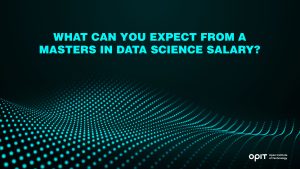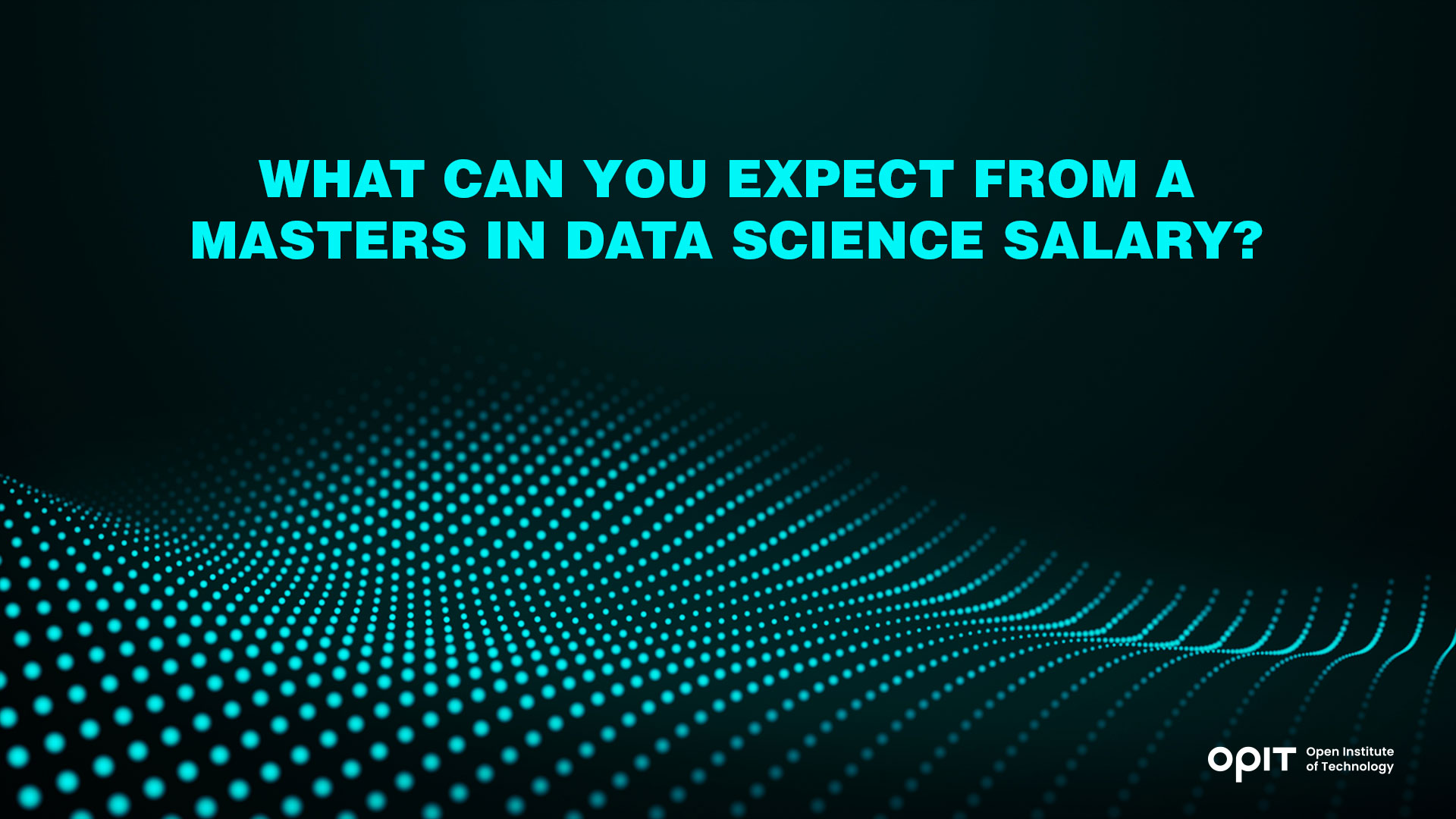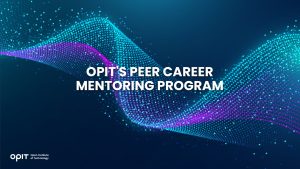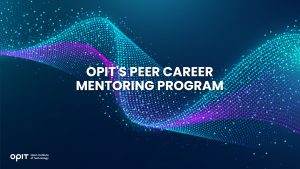

Take a sprinkling of math, add some statistical analysis, and coat with the advanced programming and analytics that enables people to pore through enormous batches of data and you have the recipe for a data scientist.
These professionals (and their data-based talents) are sought after in industries of all shapes and sizes. Every sector from healthcare, finance, and retail to communications and even the government can make use of the skills of data scientists to advance. That’s great news if you’re considering completing your Master’s degree in the subject, as your degree is the key that can unlock the door to a comfortable five-figure salary.
Here, we look at the Master’s in data science salary and explain what you can do to maximize your potential.
Masters in Data Science: An Overview
As a postgraduate degree course, a Masters in data science builds on some of the core skills you’ll learn in a computer science or information technology degree. Think of it as a specialization. You’ll expand on the programming and analytical skills you’ve already developed to learn how to extract actionable insights from massive datasets. In the world of Big Data (where companies generate more data than at any other point in history), those skills are more important than ever.
Speaking of skills, you’ll develop or hone the following when studying for your Master’s in data science:
- Data Analysis – The ability to analyze data (i.e., interpret what seemingly random datasets tell you) is one of the first skills you’ll pick up in your degree.
- Data Visualization – Where your analysis helps you to see what you’re looking at, data visualization is all about representing that data visually so that others see what you see.
- AI and Machine Learning – The nascent technologies involved in the artificial intelligence sector revolve around data, in addition to many modern AI technologies being helpful for analyzing data. You’ll learn both sides, developing the skills to both create and use AI.
- Software Engineering and Programming – Don’t assume the programming skills you have from your previous degree will go to waste, as you’ll need them for a data science Master’s. You’ll use plenty of new tools, in addition to picking up more skills in languages like Python, SQL, and R.
- Soft Skills – A Master’s in data science isn’t all technical. You’ll develop some soft skills that prove useful in the workplace, such as communication, basic teamwork, and management. Most data science courses also teach ethics so you can get to grips with the idea of doing the right thing with data.
The Top Universities for a Data Science Masters
According to the university rating website Collegedunia, there are more than 60 leading data sciences universities in the United States alone, each offering both Bachelor’s and Master’s degrees in the subject. It ranks the following as the top five institutions for getting your Master’s in data science:
- MIT – As the top data science university in the world (according to the QS Global Rankings), MIT is the first choice for any prospective student.
- Harvard University – The “Harvard” name carries weight regardless of the course you choose. Data scientists have their pick of a standard Master’s in data science or a course dedicated to health data science.
- Columbia University – Those who want to fast-track their studies may find that the intensive one-year data science Master’s that Columbia offers is a better choice than traditional two-year courses.
- John Hopkins University – Though it’s best known as one of America’s best medical schools, John Hopkins also has a strong data science department. It may be a great choice for those who want to use their data science skills to get into the medical field.
- Northwestern University – Ranking at 30 in the QS Global Rankings, Northwestern offers Master’s degrees in both data science and analytics, with the latter expanding on one of the core skills needed for data science.
Masters in Data Science Salary Potential
As great as the skills you’ll get will be, you want to know more about the Master’s in data science salary you can expect to earn.
The good news is that a strong salary isn’t just possible. It’s likely. According to Indeed, the average salary for a data scientist is £49,749 in the UK. Cult.Honeypot has interesting figures for Europe as a whole, noting that the average data scientist on the continent earns €60,815, which matches up well to general salary expectations of €60,000. You can also expect a position in this field to come with numerous benefits, including medical insurance (where relevant) and flexible working conditions.
Of course, there are several factors that influence your specific earning power:
- Geographic location
- The specific industry in which you work
- Your experience level
- The size of the company for which you work
For example, a brand-new graduate who takes a position at a start-up in a non-tech industry may find that they earn at the lower end of the scale, though they’ll develop experience that could serve them well later on.
Data scientists also tend to have higher salary prospects than those in comparable fields. For example, more data from Indeed shows us that data scientists in the UK earn more, on average, than software engineers (£49,409), computer scientists (£45,245), and computer engineers (£24,780). Furthermore, a Master’s in data science is wide-ranging enough that it’ll give you many of the skills you need for the above industries, assuming you’d want a career change or discover that data science isn’t for you.
Benefits of a Masters in Data Science for Earning Power
It’s clear that the Master’s in data science salary potential is strong, with mid-five-figure salaries being the standard (rather than the exception) for the industry. But there are benefits beyond potential earnings that make the Master’s course a good one to take.
More Job Opportunities
Data science is everywhere in modern industry because every company produces data. You can apply your skills in industries like healthcare, manufacturing, and retail, meaning you have plenty of job opportunities. The research backs this statement up, too, with figures from Polaris Market Research suggesting a 27.6% compound annual growth rate (CAGR) for the data science industry between 2022 and 2030.
Greater Job Security
The encroachment of AI into almost every aspect of our lives has many people worried about job security. Some even speculate that machines will take over many roles in the coming years. Data scientists don’t have to worry about that. Not only will you use AI to advance your research, but you may also be responsible for further developments in the AI and machine learning fields. All of which will make you crucial to the continuation of the AI trend.
Opportunities for Career Advancement
The salary figure quoted above (average salary of €60,815) is for a fairly standard data science role. Opportunities for career advancement exist, whether that be simply moving into a more senior position in a company or taking control of a team, thus adding management to your skill set. Those who prefer conducting research will also find that many universities and large companies have teams dedicated to using data science to create social and commercial change.
Tips for Maximizing Earnings With a Masters in Data Science
With the Master’s in data science salary potential already being attractive enough (six figures is a great start), you may not worry too much about maximizing your earning potential at the start of your career. But as you get deeper into your working life, the following tips will help you get more money in return for the skills you bring to the table.
1 – Choose the Right University and Program
Universities aren’t built equally, with some carrying more weight than others. For example, a data science Master’s degree from MIT holds huge weight because it’s one of America’s top universities for the subject. Employers know what the school is about, understand that those who study there undergo superb training, and will thus be more willing to both hire and offer more money to its graduates. The point is that where you go (and what you study in your course) influences how employers see you, which also influences your earning potential.
2 – Gain Relevant Work Experience
As with any career path, what you learn along the path is as valuable as the skills you pick up when studying. You can get a head start on other data science graduates if you take on internships or get involved in research projects while studying, giving you some work experience to add to your resume that could lead to higher initial salary offers.
3 – Leverage Networking and Connections
Meeting the right people at the right times can do wonders for your career. Studying for a Master’s in data science exposes you to professors (and even people who work in the industry) who can put you in touch with people who offer roles in the industry. Continuous building on these connections, from staying active in the industry to leveraging social media, offers more opportunities for advancement.
4 – Stay Up-to-Date With Industry Trends
Data science is a fast-moving sector, with constant advancements occurring at both the high level (the evolution of AI) and in terms of how we use data science in different industries. Keeping on top of these advancements means you stay “in the know” and can see potential career paths branching out before you.
5 – Pursue Additional Qualifications
Keeping with the theme of staying up-to-date, how you build on your skills via continuing education can influence your salary potential. A Master’s degree in data science is impressive. But a degree supplemented by specialized certifications, proof of bootcamp completion, and any other accolades puts you ahead of the pack of other graduates.
Turn Your Master’s in Data Science Into a Great Career
In addition to opening you up to an exciting career in a field that’s undergoing tremendous growth, a Master’s in data science comes with mid-five-figure salary potential. You can boost your Master’s in data science salary expectations through networking, specialization, and simply staying up-to-date with what’s happening in the industry.
Granted, there are time and monetary commitments involved. You usually dedicate two years of your life to getting your degree (though some universities offer one-year data science Master’s courses) and you’ll pay a five-figure sum for your education. But the benefits on the backend of that commitment are so vast that a Master’s in data science may be the key to unlocking huge earnings in the data industry.
Related posts

Source:
- Raconteur, published on November 06th, 2025
Many firms have conducted successful Artificial Intelligence (AI) pilot projects, but scaling them across departments and workflows remains a challenge. Inference costs, data silos, talent gaps and poor alignment with business strategy are just some of the issues that leave organisations trapped in pilot purgatory. This inability to scale successful experiments means AI’s potential for improving enterprise efficiency, decision-making and innovation isn’t fully realised. So what’s the solution?
Although it’s not a magic bullet, an AI operating model is really the foundation for scaling pilot projects up to enterprise-wide deployments. Essentially it’s a structured framework that defines how the organisation develops, deploys and governs AI. By bringing together infrastructure, data, people, and governance in a flexible and secure way, it ensures that AI delivers value at scale while remaining ethical and compliant.
“A successful AI proof-of-concept is like building a single race car that can go fast,” says Professor Yu Xiong, chair of business analytics at the UK-based Surrey Business School. “An efficient AI technology operations model, however, is the entire system – the processes, tools, and team structures – for continuously manufacturing, maintaining, and safely operating an entire fleet of cars.”
But while the importance of this framework is clear, how should enterprises establish and embed it?
“It begins with a clear strategy that defines objectives, desired outcomes, and measurable success criteria, such as model performance, bias detection, and regulatory compliance metrics,” says Professor Azadeh Haratiannezhadi, co-founder of generative AI company Taktify and professor of generative AI in cybersecurity at OPIT – the Open Institute of Technology.
Platforms, tools and MLOps pipelines that enable models to be deployed, monitored and scaled in a safe and efficient way are also essential in practical terms.
“Tools and infrastructure must also be selected with transparency, cost, and governance in mind,” says Efrain Ruh, continental chief technology officer for Europe at Digitate. “Crucially, organisations need to continuously monitor the evolving AI landscape and adapt their models to new capabilities and market offerings.”
An open approach
The most effective AI operating models are also founded on openness, interoperability and modularity. Open source platforms and tools provide greater control over data, deployment environments and costs, for example. These characteristics can help enterprises to avoid vendor lock-in, successfully align AI to business culture and values, and embed it safely into cross-department workflows.
“Modularity and platformisation…avoids building isolated ‘silos’ for each project,” explains professor Xiong. “Instead, it provides a shared, reusable ‘AI platform’ that integrates toolchains for data preparation, model training, deployment, monitoring, and retraining. This drastically improves efficiency and reduces the cost of redundant work.”
A strong data strategy is equally vital for ensuring high-quality performance and reducing bias. Ideally, the AI operating model should be cloud and LLM agnostic too.
“This allows organisations to coordinate and orchestrate AI agents from various sources, whether that’s internal or 3rd party,” says Babak Hodjat, global chief technology officer of AI at Cognizant. “The interoperability also means businesses can adopt an agile iterative process for AI projects that is guided by measuring efficiency, productivity, and quality gains, while guaranteeing trust and safety are built into all elements of design and implementation.”
A robust AI operating model should feature clear objectives for compliance, security and data privacy, as well as accountability structures. Richard Corbridge, chief information officer of Segro, advises organisations to: “Start small with well-scoped pilots that solve real pain points, then bake in repeatable patterns, data contracts, test harnesses, explainability checks and rollback plans, so learning can be scaled without multiplying risk. If you don’t codify how models are approved, deployed, monitored and retired, you won’t get past pilot purgatory.”
Of course, technology alone can’t drive successful AI adoption at scale: the right skills and culture are also essential for embedding AI across the enterprise.
“Multidisciplinary teams that combine technical expertise in AI, security, and governance with deep business knowledge create a foundation for sustainable adoption,” says Professor Haratiannezhadi. “Ongoing training ensures staff acquire advanced AI skills while understanding associated risks and responsibilities.”
Ultimately, an AI operating model is the playbook that enables an enterprise to use AI responsibly and effectively at scale. By drawing together governance, technological infrastructure, cultural change and open collaboration, it supports the shift from isolated experiments to the kind of sustainable AI capability that can drive competitive advantage.
In other words, it’s the foundation for turning ambition into reality, and finally escaping pilot purgatory for good.

The Open Institute of Technology (OPIT) is the perfect place for those looking to master the core skills and gain the fundamental knowledge they need to enter the exciting and dynamic environment of the tech industry. While OPIT’s various degrees and courses unlock the doors to numerous careers, students may not know exactly which line of work they wish to enter, or how, exactly, to take the next steps.
That’s why, as well as providing exceptional online education in fields like Responsible AI, Computer Science, and Digital Business, OPIT also offers an array of career-related services, like the Peer Career Mentoring Program. Designed to provide the expert advice and support students need, this program helps students and alumni gain inspiration and insight to map out their future careers.
Introducing the OPIT Peer Career Mentoring Program
As the name implies, OPIT’s Peer Career Mentoring Program is about connecting students and alumni with experienced peers to provide insights, guidance, and mentorship and support their next steps on both a personal and professional level.
It provides a highly supportive and empowering space in which current and former learners can receive career-related advice and guidance, harnessing the rich and varied experiences of the OPIT community to accelerate growth and development.
Meet the Mentors
Plenty of experienced, expert mentors have already signed up to play their part in the Peer Career Mentoring Program at OPIT. They include managers, analysts, researchers, and more, all ready and eager to share the benefits of their experience and their unique perspectives on the tech industry, careers in tech, and the educational experience at OPIT.
Examples include:
- Marco Lorenzi: Having graduated from the MSc in Applied Data Science and AI program at OPIT, Marco has since progressed to a role as a Prompt Engineer at RWS Group and is passionate about supporting younger learners as they take their first steps into the workforce or seek career evolution.
- Antonio Amendolagine: Antonio graduated from the OPIT MSc in Applied Data Science and AI and currently works as a Product Marketing and CRM Manager with MER MEC SpA, focusing on international B2B businesses. Like other mentors in the program, he enjoys helping students feel more confident about achieving their future aims.
- Asya Mantovani: Asya took the MSc in Responsible AI program at OPIT before taking the next steps in her career as a Software Engineer with Accenture, one of the largest IT companies in the world, and a trusted partner of the institute. With a firm belief in knowledge-sharing and mutual support, she’s eager to help students progress and succeed.
The Value of the Peer Mentoring Program
The OPIT Peer Career Mentoring Program is an invaluable source of support, inspiration, motivation, and guidance for the many students and graduates of OPIT who feel the need for a helping hand or guiding light to help them find the way or make the right decisions moving forward. It’s a program built around the sharing of wisdom, skills, and insights, designed to empower all who take part.
Every student is different. Some have very clear, fixed, and firm objectives in mind for their futures. Others may have a slightly more vague outline of where they want to go and what they want to do. Others live more in the moment, focusing purely on the here and now, but not thinking too far ahead. All of these different types of people may need guidance and support from time to time, and peer mentoring provides that.
This program is also just one of many ways in which OPIT bridges the gaps between learners around the world, creating a whole community of students and educators, linked together by their shared passions for technology and development. So, even though you may study remotely at OPIT, you never need to feel alone or isolated from your peers.
Additional Career Services Offered by OPIT
The Peer Career Mentoring Program is just one part of the larger array of career services that students enjoy at the Open Institute of Technology.
- Career Coaching and Support: Students can schedule one-to-one sessions with the institute’s experts to receive insightful feedback, flexibly customized to their exact needs and situation. They can request resume audits, hone their interview skills, and develop action plans for the future, all with the help of experienced, expert coaches.
- Resource Hub: Maybe you need help differentiating between various career paths, or seeing where your degree might take you. Or you need a bit of assistance in handling the challenges of the job-hunting process. Either way, the OPIT Resource Hub contains the in-depth guides you need to get ahead and gain practical skills to confidently move forward.
- Career Events: Regularly, OPIT hosts online career event sessions with industry experts and leaders as guest speakers about the topics that most interest today’s tech students and graduates. You can join workshops to sharpen your skills and become a better prospect in the job market, or just listen to the lessons and insights of the pros.
- Internship Opportunities: There are few better ways to begin your professional journey than an internship at a top-tier company. OPIT unlocks the doors to numerous internship roles with trusted institute partners, as well as additional professional and project opportunities where you can get hands-on work experience at a high level.
In addition to the above, OPIT also teams up with an array of leading organizations around the world, including some of the biggest names, including AWS, Accenture, and Hype. Through this network of trust, OPIT facilitates students’ steps into the world of work.
Start Your Study Journey Today
As well as the Peer Career Mentoring Program, OPIT provides numerous other exciting advantages for those who enroll, including progressive assessments, round-the-clock support, affordable rates, and a team of international professors from top universities with real-world experience in technology. In short, it’s the perfect place to push forward and get the knowledge you need to succeed.
So, if you’re eager to become a tech leader of tomorrow, learn more about OPIT today.
Have questions?
Visit our FAQ page or get in touch with us!
Write us at +39 335 576 0263
Get in touch at hello@opit.com
Talk to one of our Study Advisors
We are international
We can speak in:


